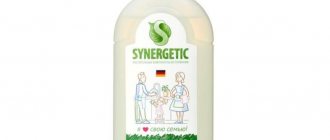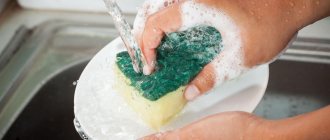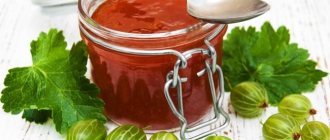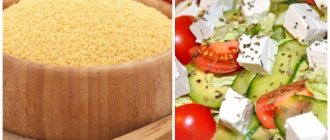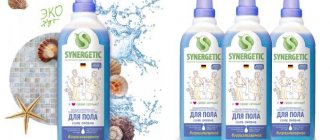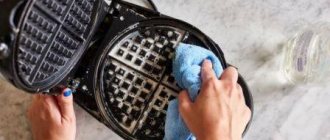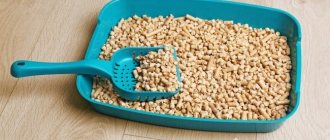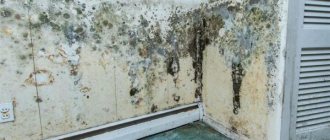What are detergents made of?
Requirements for the properties and composition of dishwashing detergent differ depending on the purpose of use. If a drug is chosen for a child or adult with allergies, the choice of composition should be especially picky.
Store-bought dishwashing detergents always consist of several components. Among them we can distinguish basic and additional ones . Children's dishwashing preparations must be marked accordingly.
Basic substances
The cleaning effect of household chemicals is achieved due to the inclusion of surfactants in the composition.
These surfactants are the main active ingredients. They come in several types:
- nonionic – quite safe, as they are biodegradable;
- ionic (ampholytic, cationic, anionic).
Potentially dangerous are surfactants, which not only promote good cleaning of dishes, but can accumulate when they enter the body. This affects the condition of various human organs.
The higher the percentage of surfactants in the composition, the greater the cleaning power of the product. The second side of the coin is that a product with a high percentage of surfactants ceases to be safe.
In order for the gel to be considered safe, the surfactant concentration must be within 5% . Read more about surfactants in detergents in this article.
Additional components
In addition to the basic substances, detergents also contain additional ones. They serve to maintain the consistency of the gel, for a pleasant aroma, to give color, etc.:
- Glycerin . Glycerin is a colorless, viscous substance that can dissolve in water. It is added to gels to soften the skin of the hands when washing dishes, as it forms a protective film and prevents the evaporation of moisture from the skin.
- Plant extracts . Plant extracts can be added to the composition to soften the skin of the hands, lightly aromatize and disinfect. These can be extracts of chamomile, other flowers and medicinal herbs.
- Table salt . Sodium chloride is often added to gels as a thickener. This component allows you to give the gel a suitable consistency for more convenient and economical use.
- Preservatives . Since dishwashing detergents made industrially have a fairly long shelf life, it is necessary to introduce additional components into the recipe that prevent the product from deteriorating. They also prevent pathogenic microorganisms from developing.
- Water . Water is a clear liquid that serves as a solvent for the components of the gel detergent. It is responsible for the liquid consistency and makes up about a third of the volume in most preparations.
Dyes . Dyes are used to give the gel a more attractive appearance and hide the not very advantageous original shade.
Eco-friendly products may not contain them at all, or they may use harmless food products.
- Enzymes . The introduction of enzymes into the composition of products makes it possible to more efficiently eliminate various types of contaminants. Certain enzymes work on specific types of stains. For example, amylase removes carbohydrate marks on dishes, etc.
- Fragrance . Fragrances are used to give products a pleasant aroma. They are included in almost all dishwashing detergents. An exception may be eco-products and preparations. Which are intended for washing children's dishes.
- pH regulators . Detergents are initially alkaline. To adjust their pH level, additional ingredients can be used, most often citric acid.
- Complexing agents (chelates) . Polycarboxylates, zeolites and other substances that soften water and prevent the deposition of salts often act as complexing agents. Some complexing agents additionally serve to better remove contaminants.
- Antibacterial substances . Such components prevent the development of microorganisms. These additives make cleaning more hygienic.
- Phosphates . The introduction of phosphates into detergents increases the toxicity of surfactants. These substances are harmful to the body, as they can penetrate into it even through the skin.
Popular manufacturers
The popularity of a product is often influenced by advertising rather than its actual characteristics. Thus, Fairy products have held the leadership in this area for many years, although studies show that they are more chemically aggressive and more expensive than many other drugs. However, they are used by more than a third of consumers in our country.
Other brands that have gained popularity as potent drugs:
- AOS “Lemon” is the most economical product, actively produces foam, is effective in cold water, and removes old stains. Disadvantages: dries the skin, can cause allergies, contains chemical fragrances and preservatives.
- Sorti “Lemon” is an inexpensive domestic analogue of Fairy. Removes fats of any origin and other types of contaminants even in low temperature water. It degreases plastic well and does not leave streaks on glass. The disadvantages are that the consistency is too liquid, that is, uneconomical, and the high concentration of synthetic components.
- Myth - the gel is economical, inexpensive and effective. Doesn't dry out the skin of your hands and has a pleasant smell. Its advantages are due to its disadvantages - the combination of low cost and high efficiency is achieved by using aggressive chemical ingredients.
Health-safe balms include harmless, biodegradable organic ingredients. You can use these products to wash food, and you can even use the leftovers to water your home flowers. Popular formulations:
- Mama Ultimate is a Japanese product containing soda. It efficiently cleans pots and plates in cold water and has a softening effect on the skin of the hands.
- Zero with mustard and honey extract is an eco-gel based on citric acid and table salt from a domestic manufacturer. It does not contain chemicals, and therefore is suitable for washing children's hygiene products, toys, and dishes.
- Synergetic (Germany) - due to its complete washability, it is suitable for washing vegetables, fruits and other food products, children's dishes, toys. Not dangerous if swallowed. The product is completely biodegradable, washes away grease and dirt even in ice water.
The only common disadvantage of all the natural dishwashing detergents listed above is their high cost for domestic buyers.
Hypoallergenic balms are not as expensive as environmentally friendly products, but will protect allergy sufferers and children from exposure to many compounds that are harmful to health. These include detergents BioMio (Russia), Sodasan Sensitive (Germany), Lion Charmy Magic (Japan), which can even be found in a pharmacy, LV (Finland), AmWay Dish Drops (USA). In the line of such products, you can choose an unscented option.
As you can see, the volume of supply on the market for dishwashing preparations is large. You can find a product to suit every taste and budget. The main thing is to consider not only the effectiveness of the product, but also its impact on health, as well as its safety for the environment.
AOS "Lemon"
Mama Ultimate
Sorti "Lemon"
Synergetic
Zero
Myth
Safe composition: myth or reality?
High efficiency and safety of dishwashing detergents requires precise selection of the composition of the preparations. The safest are those designed for children's dishes and environmentally friendly.
But these funds have their own characteristics:
- They don't foam so well.
- They have an inconspicuous whitish, yellowish or grayish tint, as they do not contain dyes.
- They do not emit a pleasant aroma, since they contain no fragrances.
- They may not be able to cope with long-standing complex stains, as they have a fairly mild composition in terms of components.
If you plan to use the product without gloves, then it should contain plant extracts, glycerin and other components that will soften the skin and protect your hands.
In addition to store-bought ones, homemade products are eco-friendly and natural .
Using folk recipes, it is quite possible to make a high-quality paste or gel yourself. In addition, it is possible to use pure soda, mustard powder and regular lemon to clean dishes.
Consistency
Based on consistency, dishwashing detergents are divided into:
Each form of dishwashing detergent has its own pros and cons that must be taken into account. Powders and pastes contain abrasives: silicon dioxide (tripoli), aluminum oxide (corundum), finely ground pumice, etc. Thanks to them, it is possible to cope with complex contaminants. They can also be used to clean the sink. The disadvantage of such products is their ability to get clogged into microcracks in dishes and not be washed out when rinsing. Liquid detergents and gels allow you to wash dishes in both hot and cold water and remove dried-on food residues. They are better washed off when rinsed, but can cause allergies and dry out the skin of the hands.
LiveInternetLiveInternet
—Categories
-Music
—Search by diary
—Subscription by e-mail
-Statistics
What is included in dishwashing detergents?
In the modern world, the housewife has a choice of a huge number of specially designed products that, as advertising claims, can wash dishes even in cold water.
And they even protect the skin of the hands from the harmful effects of detergent components, and moreover, moisturizes and cares for the hands. But are they as harmless as they are trying to impose on us, and what is included in dishwashing detergents? Do you know that over the course of a year, half a liter of detergent enters our body? Poorly rinsed dishes transfer detergent onto food and then into our bodies, plus we inhale toxic fumes while washing dishes. What is included in dishwashing detergents?
The composition of any dishwashing detergent includes surfactants - they are divided into anionic, cationic and nonionic surfactants, and it is they that determine the quality of dishwashing. An important role is played by the natural components of surfactants: carboxymethylcellulose, which prevents resorption (secondary deposition of contaminants from detergent onto washed dishes), and so-called hydrotropes, which enhance the dissolution of surfactants. Dishwashing detergents also contain auxiliary substances that improve their cleaning ability. These are alkaline salts of weak inorganic acids (phosphates of various compositions, sodium bicarbonate, sodium silicates), salts of peroxide acids, which have bleaching and disinfecting properties. Some dishwashing detergents include enzymes that remove stubborn protein stains, natural bactericides and foam stabilizers; all detergents also contain diethanolamine, which causes liver poisoning. And chlorine is used in almost all dishwashing products, you breathe in chlorine vapors, many then complain of a burning sensation in the eyes, headaches, fatigue, difficulty breathing, and all these symptoms arise in the process of regular dishwashing. Also in the composition of the detergent must include substances to impart odor; “fragrances” so that the dishes you wash smell pleasant. Many European countries abandoned all these harmful substances and switched to environmentally friendly ones twenty years ago.
The fact is that any detergent, no matter how good it is, is primarily intended to wash dishes, and not to protect your hand skin from the toxic effects of chemicals; these two different properties, which, whatever one may say, will not get along well one bottle. This is just a publicity stunt. Detergents destroy the surface lipid layer of the skin, which performs protective functions; harmful substances penetrate into the blood, causing redness of the skin of the hands, allergies, and eczema. For example, there are reviews that Ferry on the hands causes eczema, oncologists warn; Washing dishes without gloves leads to cancer. After all, housewives have to dip their hands in water with dishwashing detergent at least three times a day and breathe in the fumes.
Advertising sometimes doesn’t lie; a few drops of a really high-quality product are enough to wash 10 dishes. Do not drop the product directly onto the plate, but add it to a sponge or water. Synthetic detergent does not wash off from the surface of the dishes after a short one-time rinse; it is ALWAYS necessary to rinse the dishes for about 15 seconds in running water.
It’s scary to even imagine what could happen if instead of a quality detergent you get a fake. According to investigators, almost every tenth bottle of detergent is counterfeit. Why do counterfeit household chemicals so easily end up on store shelves and markets? Sellers sometimes don’t even know what they are selling, are not interested in the origin of the goods, and do not require certificates.
How can we ordinary consumers recognize counterfeit?
Pour a drop of detergent onto a small piece of paper. Place the sheet of paper on the tile; if the sheet slips, then the product is real; if it sticks, then it is fake.
Fraudsters try to disguise poisonous ingredients with smell. The more intense and pungent the smell of dishwashing detergent, the greater the likelihood that it is counterfeit. Keep cleaning products and detergents away from children and animals.
Do not mix several different household chemicals at once, this can provoke all sorts of chemical reactions that will harm your health; allergies, asthma, hypertension.
Doctors warn; detergents are dangerous for humans, they cause allergies in most children, encourage the development of malignant tumors, depression, hypertension, etc. Surfactants, once in the human body, break down and form peroxides that burn cell membranes.
Safe detergents and methods for making them
White vinegar (5% acetic acid solution) or lemon juice (citric acid) – removes fats and unpleasant odors
Baking soda – Cleans and deodorizes, softens water well, thereby increasing foaming and cleaning properties of soap. Baking soda is an excellent cleaning agent.
Borax, boric soap, sodium borate – Cleans and deodorizes. An excellent disinfectant that softens hard water. You can buy it in the store in the laundry department.
Soap is safe and non-toxic. Bars of soap are much easier to dissolve in warm water. Demand soap without synthetic fragrances, colors or other chemical additives. For example, Castile soap is prepared exclusively from vegetable oils - olive, palm, almond, hemp, and from the oil of the jojoba plant (jojoba), and not animal fats.
Washing soda – dissolves grease and removes stains. Disinfects. Softens water. Sold in hardware stores or in its pure form from chemical supply companies as “sodium bicarbonate.”
And soda and dry mustard perfectly clean the dirty surface of kitchen stoves. You can wash it without mustard, just half an hour before you plan to wash the stove, sprinkle it with soda and moisten it with water, everything will wash off easily.
Source
Composition of dishwashing detergent
Not all manufacturers choose high-quality and safe components for detergents, so it is important to carefully study their composition. The main characteristics of dishwashing detergents will depend on it:
- The main components aimed at removing contaminants: surfactants, alkalis, enzymes, betaine, citric acid, and also salt of mineral or organic origin.
- To make the product viscous and thick, in most cases sodium chloride, cocamide DEA and various thickeners are included in the composition.
- Various compounds with antibacterial effects are used to remove germs.
- To ensure that washing dishes does not affect the condition of the skin of your hands, manufacturers include glycerin, aloe vera gel and various extracts of medicinal plants.
- Dishwashing detergents have a good aroma, and all thanks to the presence of fragrances and various flavors.
- The color of detergent compositions is achieved through the use of different dyes and color fillers.
- The urea, benzothiazolyl and hydrotopes included in the composition make the process of breaking down contaminants faster.
- To ensure that a lot of soap suds are formed, stabilizers are included in the composition.
- To ensure that detergents do not deteriorate for a long time, manufacturers use preservatives.
- Salts of peroxide and weak inorganic acids provide disinfectant and bleaching properties.
- It is better to refuse the purchase if the composition contains components such as chlorine, phosphates and phthalates. A dangerous substance that poisons the liver is diethanolamine.
Dish detergents
It can make your head spin in front of the counter in stores, so when choosing, you need to focus on several important points:
- You should not buy products called “universal”, as they do not give good results.
- Dishwashing detergents must have a neutral pH.
- Look at products in clear packaging to make sure there is no sediment.
- Choose detergents with different additives that will protect the skin.
Liquid dishwashing detergents
Products with a consistency no thicker than water are popular. To clean a couple of pots and a set of dishes, 1 tbsp is enough. spoons, from which a lot of foam is formed. Liquid dish soap is practical because it dissolves well even in cool water. When choosing, it is better to give preference to safe balms for sensitive skin that have a neutral pH level.
Liquid dishwashing detergents also include gels, which have a thicker consistency. This group is more popular and is used by many housewives. Such cleaning agents dissolve easily and begin to act quickly, removing various contaminants and even fats. A bottle of gel lasts much longer than a regular liquid product because you can easily control the dosage and even one drop will be enough to wash several dishes.
Dish cleaning products
To remove contaminants, you can use abrasive substances - powders. They are suitable not only for washing dishes, but also sinks. It should be noted that upon contact with the skin, abrasives are not absorbed and are easily washed off. When describing which good dishwashing detergent to buy, it should be noted that powders are friable and small particles can get into microcracks in the dishes, making removal difficult. Many abrasives contain poisonous A-surfactants, and they can also scratch dishes.
Powdered dishwashing detergents are a great option for removing tough stains that liquid and gel cleaners can't handle. It is important to consider the following nuances when using them:
- It is not recommended to use abrasives for washing silver and fragile dishes if there are no appropriate inscriptions on their packaging.
- Stainless steel and ceramic dishes do not withstand the effects of powders well, as they scratch the surface.
Hypoallergenic dishwashing detergent
A very popular group of cleaning agents that contain substances of plant origin that decompose upon contact with water. A safe detergent does not affect the skin, does not cause allergies and is easily removed from the surface. In most cases, they are concentrated, so they are used sparingly. Such detergents must have a special marking on the packaging, for example, “ECO-GARANTIE”.
Dishwashing liquid concentrate
Concentrates are commonly called detergents that have a strengthened composition. Before using it, they must be diluted with water in order to ultimately obtain a clear liquid that will have a normal cleaning effect. Most concentrated products are diluted in a 1:1 ratio, but there are other instructions that are described on the packaging of the specific cleaning product. The finished solution is poured into a separate container and used. A popular detergent for washing dirty dishes is Amway, which can remove serious grease stains and dried food.
Baby dishwashing detergent
A cleaning product that is suitable for cleaning dishes for children must be safe and meet sanitary standards. It should not have strong odors, synthetic dyes or fragrances, so check the composition carefully. When choosing a detergent for children's dishes, pay attention to the following details:
- There should be a mark on the packaging that the product is suitable for children and it is better if it is environmentally friendly.
- Trust products that are suitable not only for dishes, but also for other baby feeding items, such as pacifiers.
- Another good detail is that there is an indication on the packaging that the gel is suitable for washing vegetables and fruits.
- Open the container and smell the gel, which should not have any strong odors. If the cleaning agent is good, it should be without aroma.
Disinfectant for dishes
Home disinfection is carried out when it is necessary to remove microbiological contaminants and harmful infections. If you are interested in what kind of dishwashing detergent you can use, then it is important to consider that it must have a powerful antibacterial effect, not pose a danger to people and animals, and be universal for different types of surfaces. Experts recommend choosing new organic antibacterial products that contain organic silver. They have the following properties:
- Destroy pathogenic microorganisms, viruses and fungi.
- They do not include chlorine, salts and other harmful substances, and they do not emit toxic fumes into the environment.
- They are odorless and can be used in any room.
Rating of dishwashing detergents
There are many detergents on the market, among which are the following popular options:
- Many housewives choose Fairy because this product perfectly dissolves fat. It has a pleasant aroma and thick consistency, which makes it effective.
- The “Eared Nanny” gel, which is suitable for children’s dishes, has good cleaning agents. It has an excellent antibacterial effect, removing various types of contaminants even in cold water.
- For many, the best dishwashing detergent is Amway, which is a concentrate. It contains no phosphates, and an unsurpassed effect is achieved due to the formation of a large amount of foam and the removal of complex contaminants.
- Among the organic products we can highlight ORGANIC PEOPLE, which is made from plant ingredients. Essential oils are used as fragrances. Thanks to its thick consistency, the gel is economical.
Requirements
The list of properties inherent in a good dishwasher varies depending on the purpose and nature of its use. For example, foaming gel-like preparations are suitable for lightly soiled cups and glasses, but for heavily soiled ones it is better to use powders. However, there are certain criteria for a good dish detergent. It should be:
The most attractive products for consumers are products that are conveniently packaged, have a pleasant smell, and contain added substances that soften the skin of the hands. Not all of the listed characteristics “get along” with each other, such as the ability to wash away any contaminants in cold water, environmental friendliness and low cost. When purchasing, you have to make a choice which factor is more important.
After washing, dishes must be rinsed thoroughly
Dishwashing detergent should be selected taking into account the degree of soiling
DIY dishwashing liquid
Many people prefer not to use household chemicals at all, preferring natural cleaning methods and homemade products. These include sand, wood ash, soda, mustard, vinegar, salt, laundry soap, lemon and citric acid. You can make dishwashing detergent from laundry soap that is natural and safe.
- laundry soap - 25 g;
- alcohol – 4 tbsp. spoons;
- calendula tincture – 1 tbsp. spoon;
- liquid glycerin – 25 ml;
- water – 0.5 l;
- orange or lavender essential oil – 2-3 drops.
- Grind the soap on a grater and place it in a water bath. Stir while adding water. During this process, foam will form on the surface, which must be removed.
- Remove the container from the heat and add all the other ingredients, stirring well until smooth. Pour the natural product into a container with a dispenser and use. Over time it will become thicker.
Source
Varieties
Depending on the consistency of dishwashing detergents, there are:
- liquid (gels, concentrates, balms);
- powdered and in the form of pastes.
Gels are valued for their economy (a few drops foam generously), convenience, and effectiveness in cold water. Can be regular or concentrated. The latter are economical to use, since they require dilution with water for use (according to the instructions on the package). The downside of gels is poor rinsing. Few housewives know that after cleaning dishes, they should be rinsed with a large amount of water (up to 50 liters per plate). A thin layer of toxic substances usually remains on its surface, then entering the body with food.
A variety of gel forms are balms. These are preparations to which substances have been added that care for the skin of the hands and have a moisturizing effect on it. The action of powders and pastes is based on the content of abrasives (silicon dioxide, aluminum oxide, finely ground pumice). They remove complex stains well; they can be used to clean sinks and stove surfaces, but such preparations do not wash away grease well in cold water.
